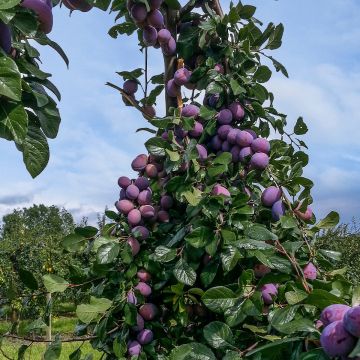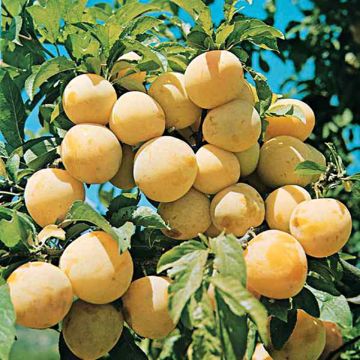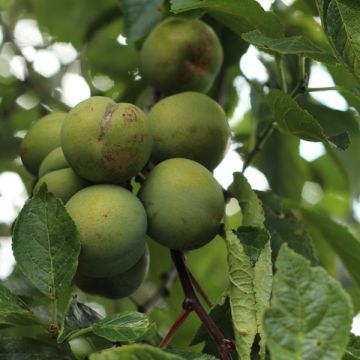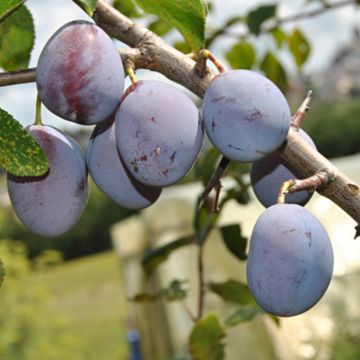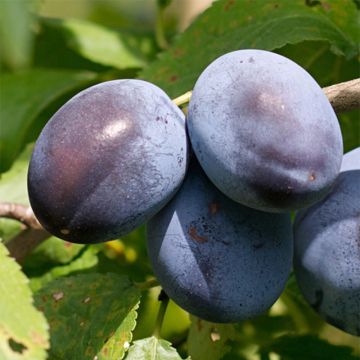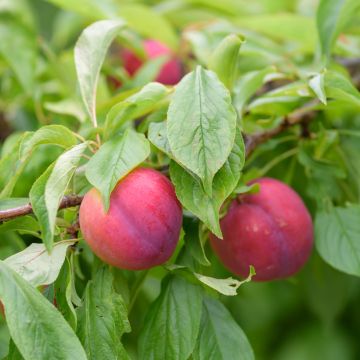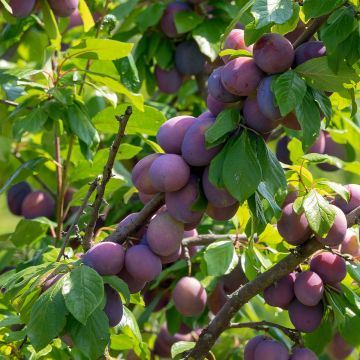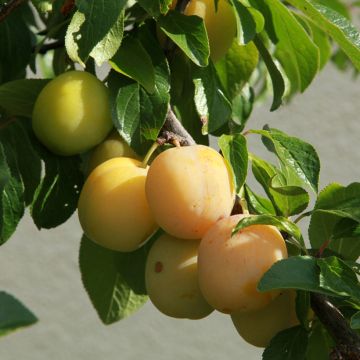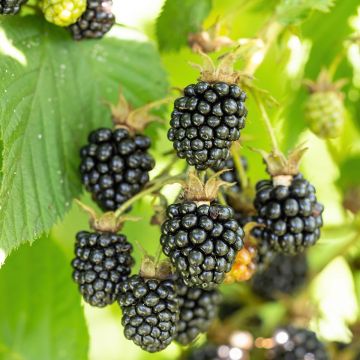Shipping country and language
Your country of residence may be:
Your country of residence is:
For a better user experience on our website, you can select:
Your shipping country:
Andorra
Austria
Belgium
Bulgaria
Canada
Chile
Croatia
Cyprus
Czechia
Denmark
Estonia
Finland
France
Germany
Greece
Hungary
Iceland
Ireland
Italy
Latvia
Lithuania
Luxembourg
Malta
Monaco
Netherlands
Poland
Portugal
Romania
Slovakia
Slovenia
Spain
Sweden
Switzerland
United Kingdom
We only deliver seed and bulb products to your country. If you add other products to your basket, they cannot be shipped.
Language:
French
German
Spanish
English
My Account
Hello
My wish lists
Plantfit
Log in / Register
Existing customer?
New customer?
Create an account to track your orders, access our customer service and, if you wish, make the most of our upcoming offers.


Prunier Quetsche Stanley Bio en racines nues, forme scion
Prunus domestica Stanley - Organic Common plum
Prunus domestica Stanley
European plum, Common plum, Garden plum
Why not try an alternative variety in stock?
View all →Order in the next for dispatch today!
Dispatch by letter from €3.90.
Delivery charge from €5.90 Oversize package delivery charge from €6.90.
More information
This item is not available in your country.
Schedule delivery date,
and select date in basket
This plant carries a 6 months recovery warranty
More information
We guarantee the quality of our plants for a full growing cycle, and will replace at our expense any plant that fails to recover under normal climatic and planting conditions.
Oversize package: home delivery by special carrier from €6.90 per order..
Express home delivery from €8.90.
Description
The 'Stanley' Plum Prune Tree is a very productive variety, resulting from a cross between a 'Quetsche' and a 'Reine-Claude'. Its production is regular, not very sensitive to alternate bearing with a rapid fruit set on plants aged 4 or 5 years. A medium-sized but vigorous fruit tree, it reaches a height of 4 to 6m (13 to 20ft), with an upright habit that spreads in adulthood. Resistant to cold and wind, it flowers in April and is well adapted to northern regions such as north of the Loire and medium-altitude gardens.
Plant from organic farming.
The 'Stanley' Plum Prune Tree is an excellent self-fertile open-pollinating variety, not requiring other trees for fertilization. In late August, it produces ovoid elongated fruits, large in size, with a purple-violet skin covered in a bluish bloom. The amber-yellow flesh is firm, fragrant, sweet, and not very juicy. The 'Stanley' Plum is consumed fresh, in jams, in pies and cakes. It is a variety that stores well and is commonly used as prunes. Its prunes can be stored for up to 2 weeks in a cool place and are resistant to handling.
The original area of plum trees is believed to be Syria, not China. During the time of Roman hegemony over the region, various local fruits including plums were introduced to Rome. The 'Reine Claude Dorée' or green plum has been known since then. The 'Stanley' Plum Prune Tree is an American variety obtained in 1926.
This fruit tree has a free and slender silhouette that is appreciated in the garden. It requires little care and maintenance thanks to its hardiness and resistance to diseases (although flowering is somewhat sensitive to Monilia). It prefers full sun or partial shade and grows in all types of rich, moist, deep, and even heavy soils, but without too much limestone.
Its leaves are oval, almost oblong, with serrated edges and slightly pubescent. Flowering occurs in April for this variety, often escaping late frosts. The tree is fully covered with white flowers that appear on the previous year's branches. They are self-fertile. This plum tree is particularly good for pollinating other plum varieties.
The plums are eaten fresh from the tree, in fruit salads, as well as in desserts, pastries, and as accompaniments to meats and dishes. They can be transformed into jams, of course, but also into preserved fruits, compotes... They can also be used to make brandy.
For transport reasons, our tallest scions may be pruned before shipping. They are suitable for all common training sizes: cordons, espaliers, goblets, half-standards, and low standards, except for high standards. If you would like more information or advice on training your fruit trees, please do not hesitate to contact us.
Prunus domestica Stanley - Organic Common plum in pictures
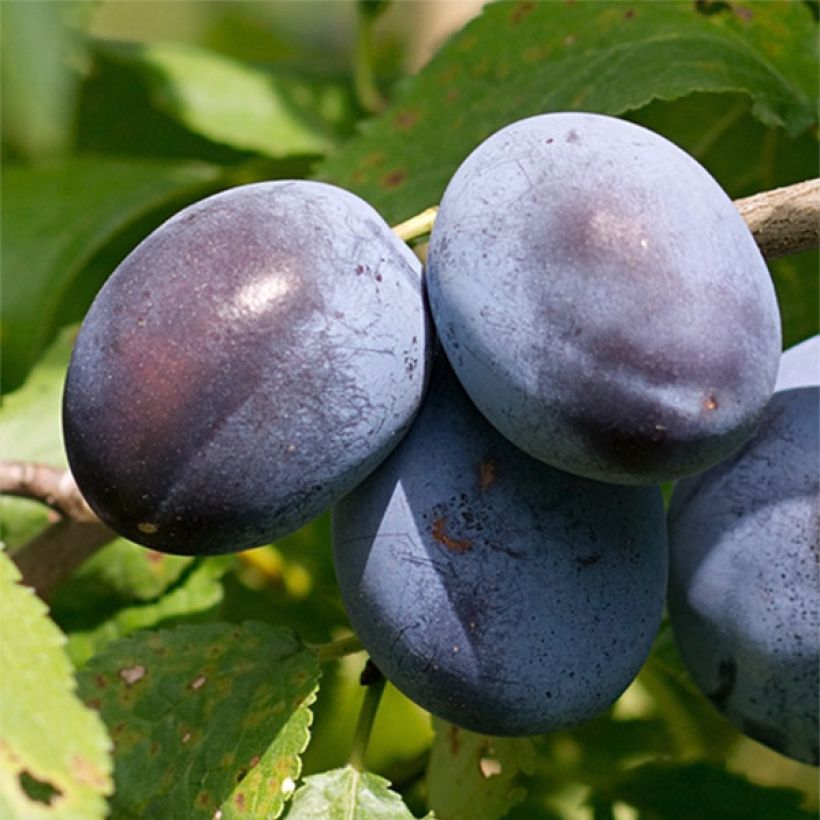

Plant habit
Fruit
Flowering
Foliage
Botanical data
Prunus
domestica
Stanley
Rosaceae
European plum, Common plum, Garden plum
Cultivar or hybrid
Other Plum Trees
Planting and care
Easy to grow, the Organic 'Stanley' Plum Tree thrives in all types of light, rich, neutral or acidic soil. It prefers a moist but not overly humid environment, and ideally without limestone. Ensure proper drainage in the planting hole by adding a thin layer of gravel. Dig a hole two to three weeks before planting, twice as wide and deep as the pot. On the day of planting, place the tree with its pot in a basin of water, allowing the roots to absorb moisture through capillary action. Add compost to the bottom of the hole. Place the tree in the hole and fill with a mixture of soil and potting soil. Do not bury the graft union. Firmly tamp down the soil around the base of the tree. The root ball should be completely covered. Water generously.
In winter, you can add a small handful of wood ash, rich in potassium, to improve fruiting.
Planting period
Intended location
Care
This item has not been reviewed yet - be the first to leave a review about it.
Self-fertilising varieties
Haven't found what you were looking for?
Hardiness is the lowest winter temperature a plant can endure without suffering serious damage or even dying. However, hardiness is affected by location (a sheltered area, such as a patio), protection (winter cover) and soil type (hardiness is improved by well-drained soil).

Photo Sharing Terms & Conditions
In order to encourage gardeners to interact and share their experiences, Promesse de fleurs offers various media enabling content to be uploaded onto its Site - in particular via the ‘Photo sharing’ module.
The User agrees to refrain from:
- Posting any content that is illegal, prejudicial, insulting, racist, inciteful to hatred, revisionist, contrary to public decency, that infringes on privacy or on the privacy rights of third parties, in particular the publicity rights of persons and goods, intellectual property rights, or the right to privacy.
- Submitting content on behalf of a third party;
- Impersonate the identity of a third party and/or publish any personal information about a third party;
In general, the User undertakes to refrain from any unethical behaviour.
All Content (in particular text, comments, files, images, photos, videos, creative works, etc.), which may be subject to property or intellectual property rights, image or other private rights, shall remain the property of the User, subject to the limited rights granted by the terms of the licence granted by Promesse de fleurs as stated below. Users are at liberty to publish or not to publish such Content on the Site, notably via the ‘Photo Sharing’ facility, and accept that this Content shall be made public and freely accessible, notably on the Internet.
Users further acknowledge, undertake to have ,and guarantee that they hold all necessary rights and permissions to publish such material on the Site, in particular with regard to the legislation in force pertaining to any privacy, property, intellectual property, image, or contractual rights, or rights of any other nature. By publishing such Content on the Site, Users acknowledge accepting full liability as publishers of the Content within the meaning of the law, and grant Promesse de fleurs, free of charge, an inclusive, worldwide licence for the said Content for the entire duration of its publication, including all reproduction, representation, up/downloading, displaying, performing, transmission, and storage rights.
Users also grant permission for their name to be linked to the Content and accept that this link may not always be made available.
By engaging in posting material, Users consent to their Content becoming automatically accessible on the Internet, in particular on other sites and/or blogs and/or web pages of the Promesse de fleurs site, including in particular social pages and the Promesse de fleurs catalogue.
Users may secure the removal of entrusted content free of charge by issuing a simple request via our contact form.
The flowering period indicated on our website applies to countries and regions located in USDA zone 8 (France, the United Kingdom, Ireland, the Netherlands, etc.)
It will vary according to where you live:
- In zones 9 to 10 (Italy, Spain, Greece, etc.), flowering will occur about 2 to 4 weeks earlier.
- In zones 6 to 7 (Germany, Poland, Slovenia, and lower mountainous regions), flowering will be delayed by 2 to 3 weeks.
- In zone 5 (Central Europe, Scandinavia), blooming will be delayed by 3 to 5 weeks.
In temperate climates, pruning of spring-flowering shrubs (forsythia, spireas, etc.) should be done just after flowering.
Pruning of summer-flowering shrubs (Indian Lilac, Perovskia, etc.) can be done in winter or spring.
In cold regions as well as with frost-sensitive plants, avoid pruning too early when severe frosts may still occur.
The planting period indicated on our website applies to countries and regions located in USDA zone 8 (France, United Kingdom, Ireland, Netherlands).
It will vary according to where you live:
- In Mediterranean zones (Marseille, Madrid, Milan, etc.), autumn and winter are the best planting periods.
- In continental zones (Strasbourg, Munich, Vienna, etc.), delay planting by 2 to 3 weeks in spring and bring it forward by 2 to 4 weeks in autumn.
- In mountainous regions (the Alps, Pyrenees, Carpathians, etc.), it is best to plant in late spring (May-June) or late summer (August-September).
The harvesting period indicated on our website applies to countries and regions in USDA zone 8 (France, England, Ireland, the Netherlands).
In colder areas (Scandinavia, Poland, Austria...) fruit and vegetable harvests are likely to be delayed by 3-4 weeks.
In warmer areas (Italy, Spain, Greece, etc.), harvesting will probably take place earlier, depending on weather conditions.
The sowing periods indicated on our website apply to countries and regions within USDA Zone 8 (France, UK, Ireland, Netherlands).
In colder areas (Scandinavia, Poland, Austria...), delay any outdoor sowing by 3-4 weeks, or sow under glass.
In warmer climes (Italy, Spain, Greece, etc.), bring outdoor sowing forward by a few weeks.

